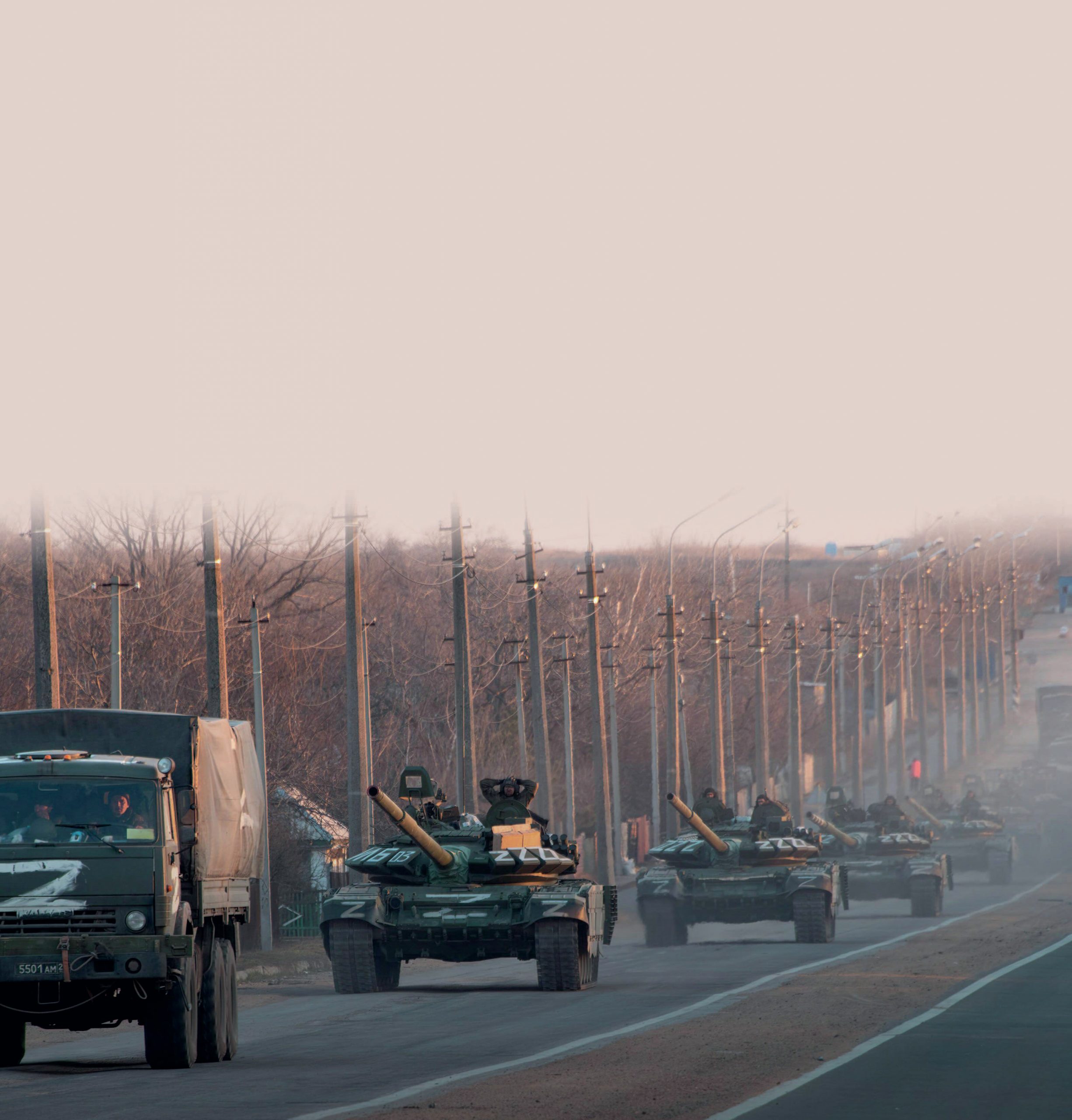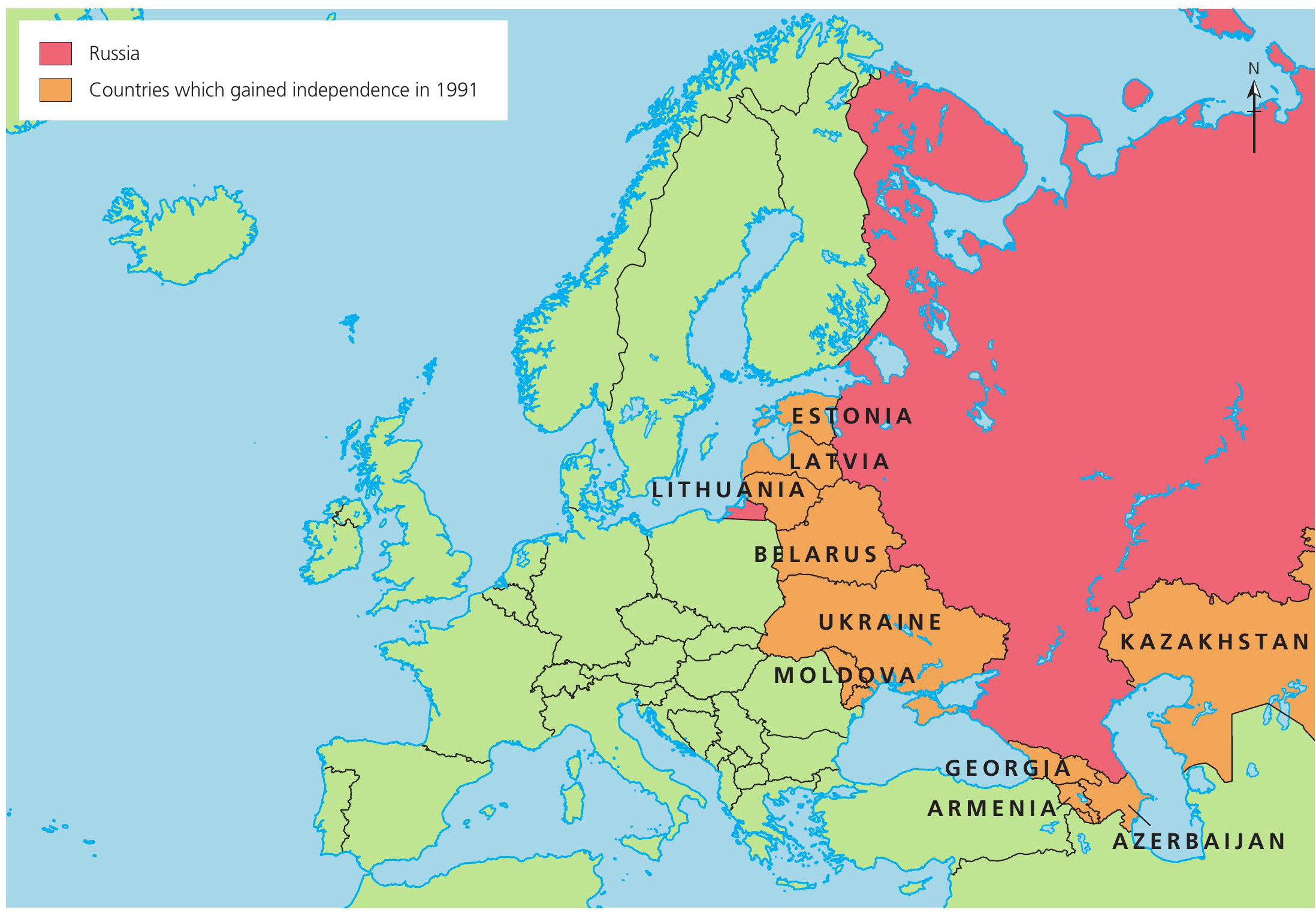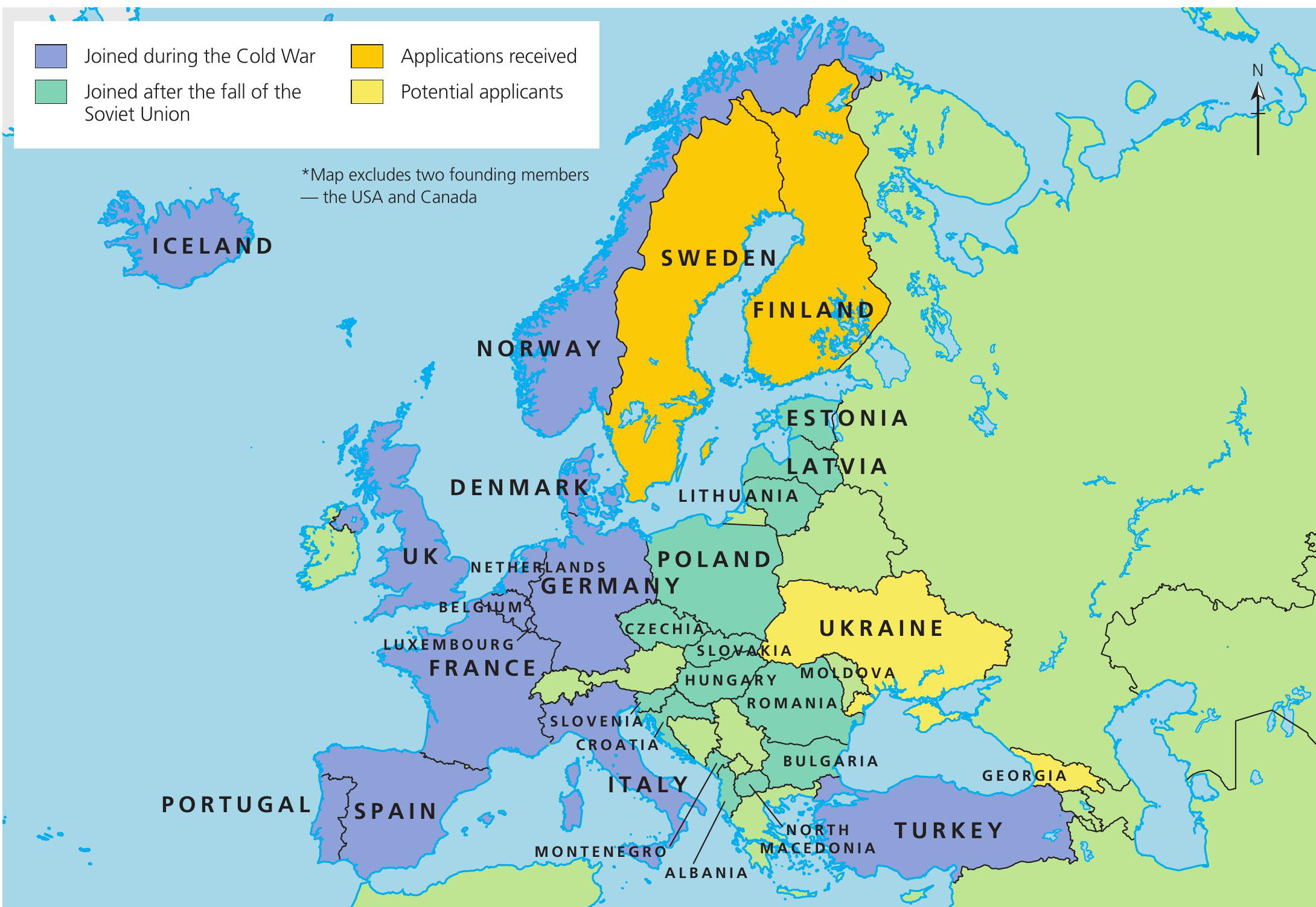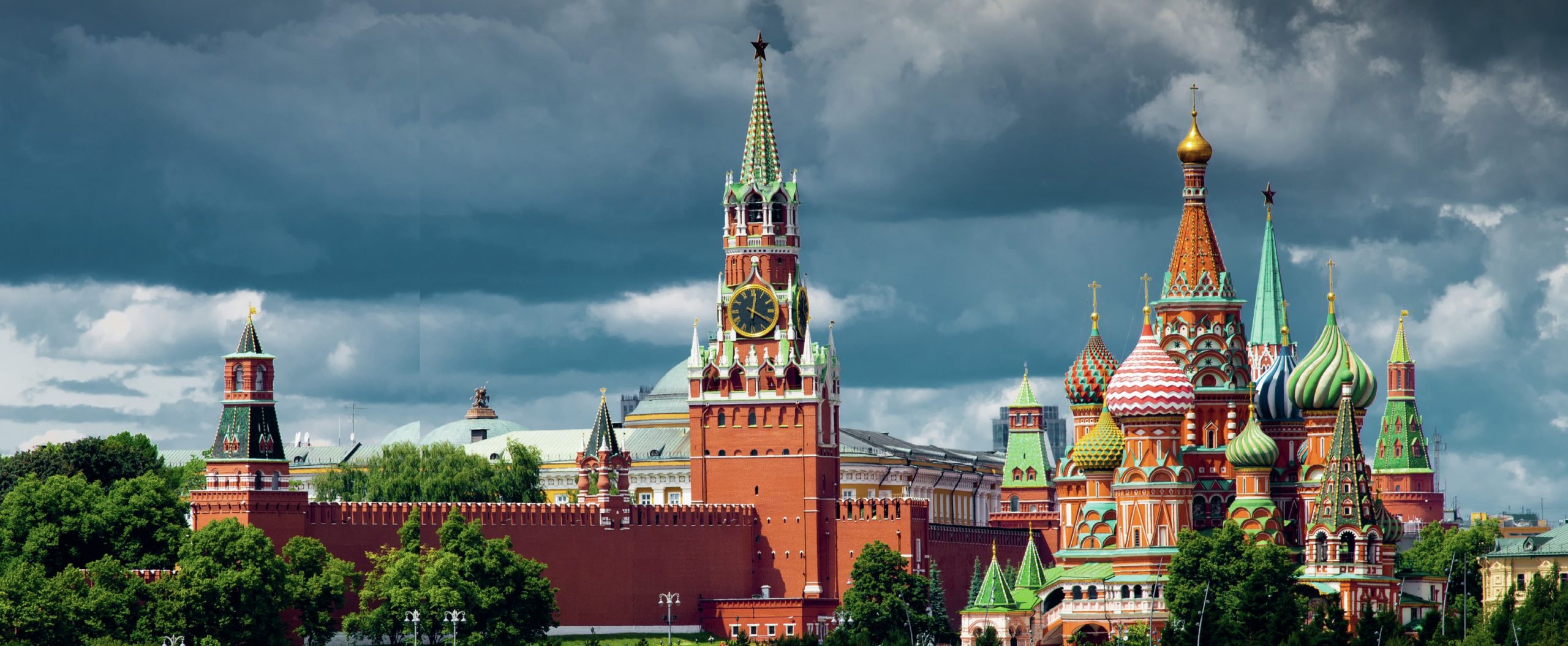Conflict in Eastern Europe
The struggle for political influence between Russia and NATO
This article demonstrates the links between superpowers, their spheres of influence and what happens when these spheres are contested by other actors

EXAM LINKS
■ Edexcel: Superpowers
The conflict between Russia and Ukraine is a consequence of Russia attempting to maintain its sphere of political and economic influence and prevent the expansion of the North Atlantic Treaty Organization (NATO) in Eastern Europe. In February 2022, Vladimir Putin, the leader of the Russian Federation, ordered the invasion of the sovereign territory of Ukraine, a nation which shares its eastern border with Russia. The conflict has led several states, such as the UK, France, Poland, Germany and the USA, to provide strategic and military support to Ukraine to help repel the invasion. The conflict is a result of tensions between NATO and the Russian Federation. Both are attempting to establish political control in Eastern Europe.

The origins of NATO and its rivalry with Russia
Before 1991, Ukraine was part of the Soviet Union — astate made up of 15 republics which are now independent countries in Eastern Europe and Central Asia. Figure 1 above shows the borders of the Soviet Union and its republics in Eastern Europe. During the Cold War (see Box 1 below), the Soviet Union was a rival of the USA and other capitalist countries in the West and Western Europe, including France, the UK and Canada. In response to the growing military power of the Soviet Union, Western states decided to form the North Atlantic Treaty Organization in 1949. During the Cold War, the organisation served as a check on the military threat posed by the Soviet Union. The alliance was based on the principle of collective defence. This means that when one NATO member is attacked by another country, other NATO members respond as if they themselves have been attacked, acting as a military deterrent.
Box 1 Cold War
The Cold War was a period of political tension between the USA and the Soviet Union and their respective allies between 1947 and 1991. During the Second World War, the Soviet Union and Western states were allies, united in their fight against Nazi Germany. After the war, the relationship between the communist Soviet Union and the capitalist USA deteriorated. The period was characterised by intense military, economic and political competition, with each superpower attempting to expand their spheres of influence to other regions. The USA was allied to other capitalist states in Western Europe and countries like Canada and Australia, while the Soviet Union was allied to other communist states like China, Cuba and Poland. The Cold War ended when the Soviet Union collapsed in 1991.
When the Soviet Union disintegrated in 1991, 15 states were able to regain their independence. Figure 1 shows some of the former soviet republics prior to 1991. In Eastern Europe, these included Ukraine, Latvia, Estonia, Moldova and Belarus. Bear in mind that the Soviet Union contained several other nations in Central Asia not shown on the map, including Turkmenistan, Kazakhstan and Kirghizstan. The disintegration of the Soviet Union has also resulted in the creation of the Russian Federation, which embraced capitalism and began to rebuild its relationship with the West.
Despite the geopolitical changes in Eastern Europe, NATO continued to operate and has since been involved in several military operations worldwide. While Russia was no longer engaged in the Cold War with Western states, its leaders continue to view NATO activities as a direct challenge to Russia’s inf luence in Central and Eastern Europe.
Russia’s attempts to control Eastern Europe
While the former Soviet republics are independent states, Russia continues to exert influence on many of its neighbours, including, but not limited to, Belarus, Georgia, Ukraine, Moldova and Kazakhstan. To maintain its geopolitical dominance in the region, Russia uses both soft and hard power.
Support and influence
In the past, Russia interfered in several parliamentary and presidential elections by financially supporting pro-Russian candidates and intimidating those who support a closer relationship with the European Union or NATO.
Russia can strengthen its political influence in the region by making trade and investment deals with its neighbours and, as one of the biggest oil and gas exporters in the world, by offering energy at low prices. It is also able to withdraw from economic agreements or even halt energy supplies as punishment for unfavourable policy decisions. When Russia stopped its supply of oil to Ukraine in 2006, many commentators speculated that it did so in response to Ukraine’s improved relationship with NATO and the West.
Russia has also been accused of supporting various separatist movements in neighbouring countries. For example, it provided political, financial and military support to separatist movements in Ukraine and Georgia.
All these activities help Russia dominate the region by shaping the domestic and international relations of its neighbours.
Military force
Russia has also been known to use military force to achieve its aims in Eastern Europe and Central Asia. In 2008, as Georgia struggled to contain an outbreak of separatist violence in two of its regions, Russia invaded the country over a 5-day period. In 2014, Russia also launched a military operation to annex Crimea — a Russian-speaking part of Ukraine. In both instances, Russian politicians claimed that the interventions were meant to protect the population of these regions against violence and repression from Georgian and Ukrainian governments. However, many Western commentators believe that these attacks were a direct response to the Georgian and Ukrainian presidents expressing an interest in becoming members of NATO at the time.
The expansion of NATO
As already mentioned, NATO has continued to operate even after the Soviet Union ceased to exist. Over the years, NATO has admitted more members in Europe, with successive expansions including the former communist states Poland and Romania, and former Soviet republics like Lithuania, Latvia and Estonia. Figure 2 demonstrates NATO’s waves of expansion between 1949 and 2020.

Why join NATO?
Many of the new member states were seeking to gain more independence from Russia in the years following the collapse of the Soviet Union. NATO membership offered a protection from Russian interference, giving the new states more freedom in choosing their future policies.
NATO’s aims
For NATO, expanding to Eastern Europe was an opportunity to influence the economic and political direction of Eastern European states. Many leaders in countries like the USA or the UK believed that capitalist and democratic states are more peaceful. By admitting countries like Poland, Estonia or Hungary to NATO, they hoped to strengthen their democratic institutions and encourage a free market economy, bringing more stability to the region.
At the same time, NATO was hoping to make it more difficult for Russia to regain its sphere of influence in Eastern Europe. Although Russia was no longer a communist country in the 1990s, it was very politically unstable. The expansion of NATO was a way to limit Russia’s power if it chose to engage in more aggressive politics in the future.
Russia’s concerns
As NATO grew bigger, Russia has been vocal in its criticism of the alliance, accusing it of infringing on the Russian sphere of political and economic influence. While Russia was opposed to other former Soviet republics joining NATO, Ukraine’s ambition to strengthen its ties with the West has been perceived as particularly problematic in the Kremlin. Russia and Ukraine share historical roots dating back to the founding of the original Russian state. Centuries before the formation of the Soviet Union, Ukraine and Belarus were part of the Russian empire, and the Orthodox Church — recognised by both Russians and Ukrainians — has its headquarters in Moscow.
In addition, many Ukrainians in the eastern regions of the country, including Kyiv, speak Russian as their first language. For these reasons, even when Ukraine sought to become more independent from Russia and strengthen its ties with the West, Russia wanted to continue exerting political control over the country. Ukraine’s membership of NATO would represent a complete breakdown in Ukraine–Russian relations and limit Russia’s use of political and military power in the region. NATO’s policy of collective defence would mean that any future Russian interventions would result in direct military conflict with other NATO members, including the USA. Russia’s invasion of Ukraine in February 2022 was a direct result of Ukraine’s effort to join the alliance.
In the weeks preceding the invasion of Ukraine, Russia issued a list of security demands that were needed to lower the tensions in Eastern Europe. The key requirements were specifically linked to NATO’s presence in the region. Russia demanded that NATO ruled out accepting Ukraine as a member, and it requested that NATO troops and weapons are withdrawn from any country that joined the alliance before 1997. As can be seen in Figure 2, this means that NATO would effectively need to withdraw from Eastern and Central European states like Poland, Romania, Latvia or Estonia.
Why did NATO refuse Russia’s demands?
For NATO members, Ukraine’s political alignment is crucial in the battle for political influence in Eastern Europe. Following Russia’s invasion of Georgia in 2008 and the forceful annexation of Crimea in 2014, NATO members are concerned that Russia might begin to assert itself more forcefully in the region and might use military force to pursue its goals in other European countries. There is evidence that Russia has been expanding its sphere of economic and political influence beyond Eastern Europe to the Balkans and that it is trying to destabilise the region by sowing discord and undermining democratic institutions.
Russia’s more aggressive stance in Eastern Europe and its expansionist ambitions mean that NATO members were unwilling to concede to Russia’s demands that Ukraine be banned from joining the alliance. As a result, Russia invaded Ukraine in February 2022.

Stronger NATO after the invasion
Early in the dispute, Russia’s goal was to weaken NATO and lead to its withdrawal from Eastern Europe. However, the invasion of Ukraine has had the unintended consequence of bringing Western states together. In February 2022, formerly neutral Finland and Sweden expressed their interest in NATO membership and were formally invited to join the alliance in June 2022. This is a significant development because it symbolises the renewed importance of NATO as an organisation which is crucial to maintaining the national security of many European countries and as a significant deterrent to Russian military power in particular.
In addition to attracting new members, NATO has also redrawn its mission statement to focus on the Russian threat once again. This is the first time since the end of the Cold War that Russia is an official target of the alliance. The West has also acted in unison to impose wide-ranging economic and political sanctions on Russia and to supply military support to Ukraine to help defend itself from Russian aggression. While there is no fighting between Russia and Western states, the conflict in Ukraine is often seen as a ‘proxy war’ between Russia and NATO.
The invasion of Ukraine has also forced Western states to reconsider their economic relationship with Russia, which supplies a large share of oil and gas to Europe. Many NATO and European Union states have committed to limit the amount of energy they import from Russia to weaken its economy and make it harder to fund the invasion. These actions led to energy shortages in Europe and caused major economic disruption. It is therefore clear that the competition between Russia and NATO has both military and economic components.
Conclusion
The invasion of Ukraine is a direct result of the competition between NATO and the Russian Federation, which are attempting to exert inf luence over Eastern Europe. The Russian Federation is concerned by NATO’s expansion to the east near its borders, while NATO is concerned by Russia’s attempts to maintain its sphere of influence by force and its threat to other European states. As a result of these tensions, the Russian Federation invaded the territory of Ukraine in 2022 and it is currently involved in an indirect political and economic conflict with NATO states.
Question for discussion
What is the difference between soft and hard power? Discuss examples of where Russia has used both in its relations with neighbouring countries.
KEY POINTS
■ Russia uses both soft and hard power to maintain political influence with its neighbours.
■ NATO countries compete with Russia over influence in Eastern Europe.
■ Russia’s aggression in Ukraine is a result of Ukraine’s ambition to join NATO.
■ The NATO alliance has become stronger as a result of Russian invasion of Ukraine.
RESOURCES
The Council on Foreign Relations has a useful article which explains the conflict in Ukraine: www.tinyurl.com/3ktyxy6h.
The National Geographic website explains the Cold War in more detail: www.tinyurl.com/3aeuamad.





